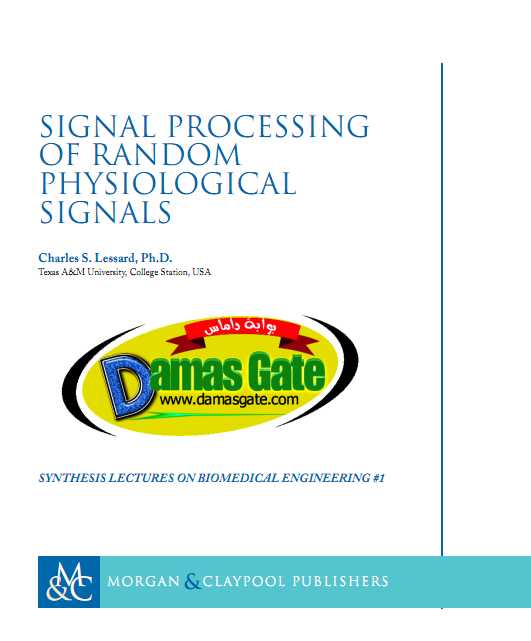Signal Processing of Random Physiological Signals - Charles S. Lessard

ABSTRACT
This lecture book is intended to be an accessible and comprehensive introduction to
random signal processing with an emphasis on the real-world applications of biosignals.
Although the material has been written and developed primarily for advanced undergraduate
biomedical engineering students it will also be of interest to engineers and interested
biomedical professionals of any discipline seeking an introduction to the field. Within
education, most biomedical engineering programs are aimed to provide the knowledge
required of a graduate student while undergraduate programs are geared toward designing
circuits and of evaluating only the cardiac signals. Very few programs teach the
processes with which to evaluate brainwave, sleep, respiratory sounds, heart valve sounds,
electromyograms, electro-oculograms, or random signals acquired from the body. The
primary goal of this lecture book is to help the reader understand the time and frequency
domain processes which may be used and to evaluate random physiological signals. A
secondary goal is to learn the evaluation of actual mammalian data without spending
most the time writing software programs. This publication utilizes “DADiSP”, a digital
signal processing software, from the DSP Development Corporation.
KEYWORDS
Signals, Processes, Time Domain, Frequency Domain, Random Data
1.1 INTRODUCTION
The purpose of this book is to present the most widely used techniques in signal and
system analysis. Individuals should have sufficient working knowledge of mathematics
through calculus and some physiology and be familiar with the elements of circuit theory
(i.e., you can write both loop and node equations for passive and active circuits) to gain the
most knowledge. Extensive programming ability is not necessary if an individual wishes
to apply some of the signal-processing principles, and it is recommended that the individual
link to DSP Corporation web site (*) and try the Student
version of the digital signal-processing software package called “DADiSP.” The material
contained herein should serve as an introduction to the most widely used techniques in
analog and discrete (digital) data and signal-processing analysis of physiological data.
Download
*

ABSTRACT
This lecture book is intended to be an accessible and comprehensive introduction to
random signal processing with an emphasis on the real-world applications of biosignals.
Although the material has been written and developed primarily for advanced undergraduate
biomedical engineering students it will also be of interest to engineers and interested
biomedical professionals of any discipline seeking an introduction to the field. Within
education, most biomedical engineering programs are aimed to provide the knowledge
required of a graduate student while undergraduate programs are geared toward designing
circuits and of evaluating only the cardiac signals. Very few programs teach the
processes with which to evaluate brainwave, sleep, respiratory sounds, heart valve sounds,
electromyograms, electro-oculograms, or random signals acquired from the body. The
primary goal of this lecture book is to help the reader understand the time and frequency
domain processes which may be used and to evaluate random physiological signals. A
secondary goal is to learn the evaluation of actual mammalian data without spending
most the time writing software programs. This publication utilizes “DADiSP”, a digital
signal processing software, from the DSP Development Corporation.
KEYWORDS
Signals, Processes, Time Domain, Frequency Domain, Random Data
1.1 INTRODUCTION
The purpose of this book is to present the most widely used techniques in signal and
system analysis. Individuals should have sufficient working knowledge of mathematics
through calculus and some physiology and be familiar with the elements of circuit theory
(i.e., you can write both loop and node equations for passive and active circuits) to gain the
most knowledge. Extensive programming ability is not necessary if an individual wishes
to apply some of the signal-processing principles, and it is recommended that the individual
link to DSP Corporation web site (*) and try the Student
version of the digital signal-processing software package called “DADiSP.” The material
contained herein should serve as an introduction to the most widely used techniques in
analog and discrete (digital) data and signal-processing analysis of physiological data.
Download
*